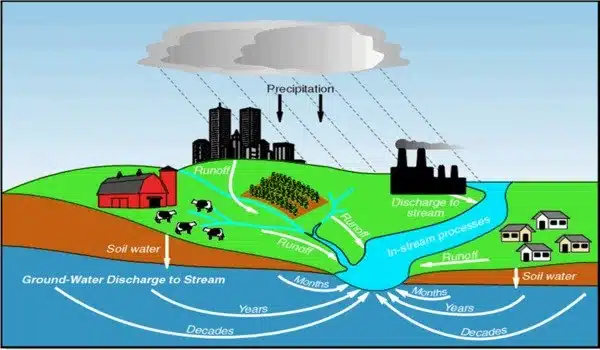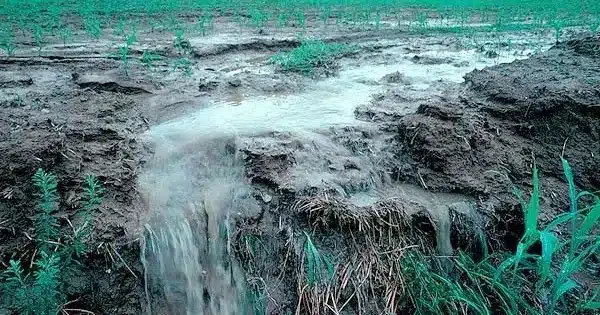Nutrient runoff from agricultural production is a major source of water contamination in the United States, and climate change, which causes extreme weather events, is expected to increase the problem. A new study from the University of Illinois Urbana-Champaign investigates the effects of heavy rainfall on runoff and recommends potential mitigating techniques.
“We look at more than a decade of precipitation events in the state of Wisconsin and quantify the increase in nutrient runoff right around the event and at the end of the growing season. Climate models predict that we’ll continue to see an increase in extreme events, and our works speaks to the challenging relationship between nutrient use and water quality,” said Marin Skidmore, assistant professor in the Department of Agricultural and Consumer Economics, part of the College of Agricultural, Consumer and Environmental Sciences (ACES) at U. of I. Skidmore is lead author of the study with coauthors Jeremy Foltz from University of Wisconsin-Madison and Tihitina Andarge from the University of Massachusetts-Amherst.
“Our focus on a single state allows us to accurately measure farm locations and practices, while keeping statewide regulation constant, in a way that would be difficult in a national study,” he said.
Our focus on a single state allows us to accurately measure farm locations and practices, while keeping statewide regulation constant, in a way that would be difficult in a national study.
Marin Skidmore
Nonpoint source pollution from agriculture is mostly caused by livestock dung and agricultural fertilizer. Wisconsin has a substantial dairy business, with most farms falling below the federal definition of concentrated animal feeding operations (CAFOs) and thus not subject to Clean Water Act regulation. They are instead subject to a patchwork of municipal restrictions.
From 2008 to 2020, the researchers evaluated water quality in roughly 50 Wisconsin watersheds. then connected ammonia and phosphorus concentration data from the Water Quality Portal with animal farm and crop acreage locations, and then calculated nutrient levels after 12 inch, 1 inch, and 2 inches of rainfall.
They discovered surges in nutrient concentrations immediately following extreme precipitation events, and the effect increased with precipitation amount. Ammonia, for example, was 49% greater five days after an inch of precipitation, while phosphorus was 24% higher. Monthly ammonia was 28% higher and monthly phosphorus was 15% higher if there was at least one day in a month with more than an inch of precipitation.

“We observe a significant interaction between rainfall, agricultural production, and runoff. It is not just a short-term spike in nutrient levels; at the end of the season, we still see persistent increases in phosphorus and ammonia attributed to those extreme precipitation events months earlier,” Skidmore stated.
The researchers discovered, however, that agricultural management measures can help lessen the effects.
“Our findings show that winter cover crops can reduce the amount of nutrients in the water.” Cover cropped areas had considerably lower ammonia and phosphorus spikes, and the effect lasts until the conclusion of the growing season. We already know cover crops are good for soils and nutrient management, but this is more empirical evidence that cover crops are climate-smart practices that can help agriculture be more resilient in the future,” Skidmore explained.
The researchers also discovered the presence of legacy nutrients, which are residues of agricultural practices that occurred decades or even centuries ago.
“There is a direct impact of extreme precipitation on runoff that is unexplained by current activities. We attribute this to sedimented nutrients that remain in the soil from previous activities,” Skidmore noted. “One of the best ways to deal with legacy nutrients is to ensure soils are healthy. By preventing soil erosion, you keep the legacy nutrients in the soil and out of surface water. These findings further support the use of management practices such as conservation tillage, vegetative buffer strips, and cover crops.”
Wisconsin’s watersheds feed the Mississippi and Great Lakes/St. Lawrence river systems, which are North America’s two largest river systems. Nutrient pollution can have immediate local consequences, such as harmful green algal blooms to humans and animals. When people are unable to participate in recreational activities such as swimming or fishing, local economies suffer. Furthermore, the Mississippi River’s downstream effects continue into the Gulf of Mexico, where nutrients contribute to a spreading dead zone.
Finding solutions to nutrient contamination benefits both the ecosystem and society as a whole, according to Skidmore.
“Because conservation strategies are not always cost-effective for producers, we must ensure that policies are in place to support their implementation.” As we approach the next Farm Bill, there is debate over how to allocate funding from the Inflation Reduction Act to climate-smart and conservation agriculture initiatives. It is critical that such methods continue to be funded so that farmers can provide those benefits for all of us,” she added.













